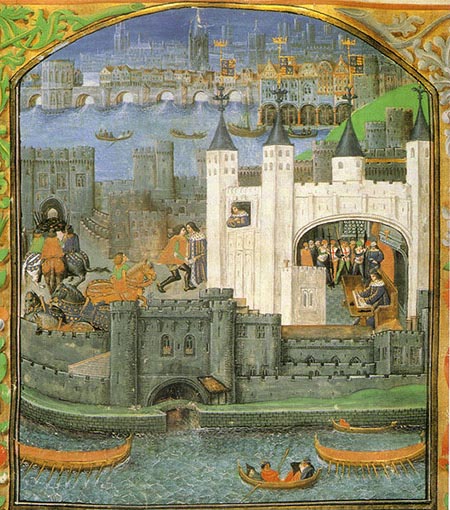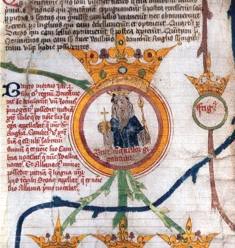DRUID WAYS AND LONDON'S LEYS

The White Tower of London. Originally built over a Druid or possibly Neolithic sacred mound.

The White Tower of London. Originally built over a Druid or possibly Neolithic sacred mound.
A thousand years before the coming of the Romans, the city of London was dominated by moors and marshes through which meandered the oxbows of the River Tammuz – named after the Mesopotamian god of resurrection – also known in more remote times as the Isis. But far from being sparsely populated territory, London c.1000 BC was a thriving Druidic center. As surprising as it may seem, around and beneath the present convoluted metropolis of buildings and roads there is still evidence of ancient temples and sacred sites, each purposefully placed and aligned, and taking advantage of universal laws associated with the manipulation of subtle energy.
The Welsh referred to this settlement as Llandin, and the original site stood on high ground, 322 feet above the marshy plains and five miles northwest of the present city center. The hilltop was used by the Druids as a gorsedd – a meeting place or sacred throne – marked by a prehistoric artificial conical hill of unknown provenance which, like so many others in the Celtic world, provided a focal point for the making of laws, civil affairs and the settlement of disputes, and this original function is preserved to this day in the name of the present site, Parliament Hill.
But there was another reason why this mound, resembling a pregnant belly, and from which the dome of St. Paul’s cathedral is clearly visible, became a focal point of prime importance for ancient cultures. The root of the word Llandin is Welsh, llan meaning ‘sacred’ and din meaning ‘mound or eminence’. At this sacred mound, therefore, religious affairs were also discussed, and veneration of the invisible world of gods was made – the world of spirits and other elements of nature that were believed to guide the actions of the universe and everyone who lived within it. And from this, modern-day London derives its name. Thus when we look at London as a mere world financial center and endless morass of brick and slate, we forget that at its heart lies a sacred origin, not to mention an ancient blueprint of sacred connections, both visible and invisible.
Besides Celtic tribes such as the Welsh, London’s earliest and distinguished lords could not herald from a more faraway place: Troy. The legends of the British Isles are ripe with stories of how the Trojan king Brutus was exiled to Albion, then the name of Britain. Having sailed past the shores of Portugal and the westernmost point of Europe, he and his Trojan contingent landed in the English town of Totnes. There, to this day, stands the town’s most prominent feature, an artificial conical hill, from where the town derives its sacred name (tot = sacred mound). Brutus is then said to have sailed up the River Tammuz, and upon seeing so many mounds, was so reminded of his home he decided to found a new Troy.
Keen to ingratiate themselves with the local Celts, the Trojans named the new city in the local language, Caer Troia. But the name never stuck, and thus it reverted to the original Llandin, the place of the sacred eminence. No doubt this pleased the resident Arch-Druid, whose own seat was a high ground four miles south of the Llandin, near the river. On this rise stood a magnificent stone circle, and beside it, Brutus added a temple dedicated to the Greek goddess associated with Light, Artemis. Veneration of the site continues to this day, for it is now superimposed by the lofty dome of another equally magnificent temple, St. Paul’s cathedral.

Brutus of Troy. And London.
A little to the southeast of the stone circle stood a large menhir – typically a tall standing stone marking the node of two or more converging lines of magnetic force – which may have provided a sightline for the circle due to its alignment to the rising of the sun on the Winter Solstice; the stone’s other function was to mark the spot from which all distances across Britain were measured, thus the site was also of considerable geodetic significance. Like so many other sacred stones, this particular menhir was held with great superstition, in fact the fate of London was said to depend on its preservation and maintenance; even as far back as ancient Egypt, temple-builders have warned of the consequences of disrupting the energy of a sacred site by tampering with its anchoring stones, because they literally root the magnetic forces of the Earth to the spot, as the Biblical King David discovered for himself when he and his high priest tampered with the sacred stone of Jerusalem and threatened to bring down the ancient city.
Indeed it seems such scholarly advice was meant to be heeded. Once the heathen Romans took over London they added an underground temple dedicated to Mithras, whose cult found particular favour among the Roman military, then appropriated the adjacent monolith as a mile post. After this desecration the fortunes of London certainly went downhill, and in 1666 London burned to the ground. When the architect Sir Christopher Wren rebuilt the city using a blueprint based on the ancient system of sacred geometry and Kaballah, one of the churches he had rebuilt was St. Swithin, which for three centuries had stood beside the menhir like a protective uncle. Wren, a practicing member of the Invisible College (a form of early Freemasonry) and a keen observer of ancient systems of knowledge and its subtle effects, moved to have the stone encased in a larger, protective stone to secure its preservation, yet barely fifty years later the stone became seen as a hazard to the increasing traffic of medieval London. Consequently, it was moved and incorporated into the walls of the rebuilt church, where it stood protected by iron railings until the Luftwaffe bombed and razed the building in 1940. What remained of the stone was moved to a humble location, a small alcove across from Cannon Street rail station.
Continue to part II
Return to Articles